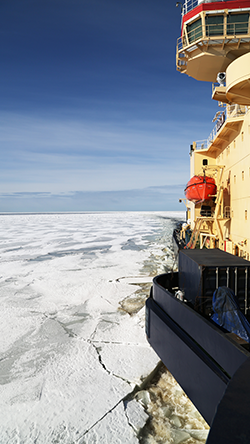International research cruise underway in the Arctic Ocean
PSL studies how ice may affect cloud structure and ocean-atmosphere processes

Breaking ice – a view from the Oden. Photo by Stella Papadopoulou, Stockholm University
|
July 25, 2014
Despite how far humans have advanced technology, communications and travel, there are still many mysteries yet to be uncovered in the icy and remote Arctic; an important region driving some of Earth’s weather and climate systems. From July through early October, researchers from the NOAA Earth System Research Laboratories’s Physical Sciences Laboratory (PSL) are part of an international, multi-disciplinary research cruise in the Arctic Ocean aboard the Swedish icebreaking ship Oden. Their measurements of sea ice, ocean and atmosphere interactions will eventually help researchers improve weather and climate forecasts.
While the PSL scientists focus on the atmosphere, geologists participating in this Swedish/Russian/US expedition, called SWERUS-C3, will collect sediment and water samples along the east Siberian continental shelf slope to learn more about methane seeps.
The atmospheric science team includes PSL researchers, and others from the University of Stockholm and the University of Leeds. They will collect comprehensive meteorological observations, which can be used for research on a variety of physical processes, and will be incorporated into the overall environmental analysis of the expedition.
The icebreaker Oden will cross areas of open water and areas coated with thick sea ice, giving the researchers a chance to investigate how the ice affects connections between the ocean and the atmosphere. Of special interest to the atmospheric team is learning about the possible effects of the Marginal Ice Zone (ice edge) on the ocean-atmosphere boundary layer, and the structure of clouds.
"The Marginal Ice Zone is a new type of environment that wasn’t seen in this region before 2005," says Ola Persson, a CIRES researcher at PSL. "We'll be looking at how the layer between the ocean and atmosphere changes over water and over the ice."
A suite of sensors and radars will capture typical atmospheric conditions (such as air temperature, pressure, humidity), as well as winds from the ocean surface to about 3,000 meters in the air, and wave sizes. The University of Leeds is also bringing a radar that will provide images of ice from 3-10 meters using satellites. The team may also be able to observe first-hand how storm conditions break up the ice.
"This is all very exciting, because it's the first time anyone has gathered this type of in situ data," says Persson. "The expedition should be able to measure local features that may be unique."
Upper ocean temperatures could be reflected in atmospheric measurements, and researchers hypothesize that the amount of summer heat being stored in the ocean could affect the jet stream at midlatitudes during the fall/early winter.
"We want to know how much heat is being stored and how much is coming out of the ocean," continues Persson. "Hopefully we’ll see some low-level jets due to changes at the ice edge.”
Some scientists think clouds have a different make up over ice compared to open water; important because cloud structure impacts the solar radiation hitting Earth's surface. PSL’s Cloud Radar will collect the data needed to find out what those differences might be.
A bonus for the atmospheric team is the opportunity to compare data from the Oden with observations collected at NOAA Arctic Atmospheric Observatories in Tiksi, Russia, and Barrow, Alaska, and by PSL and Japanese collaborators onboard the Japanese research ship Mirai in the nearby Chukchi Sea. Such comparisons will help verify the accuracy of the data, and provide a more detailed look at what’s going on.
"All the data collected during this cruise can work together to create a more complete picture," says Persson. "We should be able to add up observations at a given location based on how clouds or the atmospheric boundary layer may vary across the ice edge.”
Contacts
- Ola Persson and Matthew Shupe, CIRES scientists at NOAA/ESRL Physical Sciences Laboratory
- Barb DeLuisi, Communications Specialist, NOAA/ESRL Physical Sciences Laboratory
- Katy Human, Communications Director, CIRES




